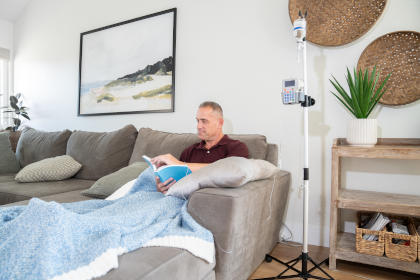
您是否患有免疫缺陷病或自身免疫性疾病?如果是,免疫球蛋白 (IG) 疗法或许能挽救您的生命。该疗法可以在家中或在医疗保健提供者的诊室进行,具体取决于具体情况。 品牌 以及如何给予。
与专家交谈
关于共付额援助如果您目前在家接受免疫球蛋白G(IG)治疗,出于多种原因,您可能会考虑将治疗地点转移到医疗保健提供者的诊所。虽然这是可行的,但了解转换过程中可能面临的挑战至关重要。在本文中,我们将探讨将IG治疗转移到医疗保健提供者诊所的实际成本和挑战。
什么是IG疗法?
免疫球蛋白 (IG) 疗法或 IG 替代疗法是一种为患者提供抵抗感染所需抗体的治疗方法。 免疫球蛋白 (抗体)是从健康捐献者的血液中提取的。这些免疫球蛋白通过对抗病毒和细菌等外来病原体来帮助预防感染。
如果您患有原发性免疫缺陷症或其他影响免疫系统产生抗体能力的疾病,您可能接受免疫球蛋白治疗 (IG)。免疫球蛋白治疗通常通过静脉 (IV) 输注或皮下 (SC) 注射注入体内。通过静脉输注进行的免疫球蛋白治疗称为 免疫球蛋白,当通过皮下注射给药时,它被称为 四川国际集团无论是静脉注射免疫球蛋白 (IVIG) 还是脊髓损伤免疫球蛋白 (SCIG),您都会接受相同的免疫球蛋白产品。您通常可以在家中或在医疗保健提供者的诊所接受静脉注射免疫球蛋白 (IVIG) 和脊髓损伤免疫球蛋白 (SCIG)。
免疫球蛋白(IG)疗法只能提供暂时的感染保护。单剂量静脉注射免疫球蛋白(IVIG)或脊髓性肌炎球蛋白(SCIIG)可为您提供1至4周的保护,具体取决于具体产品。因此,您必须定期接受免疫球蛋白(IG)疗法。如果您患有原发性免疫缺陷病,则必须终生接受免疫球蛋白(IG)疗法。1][2].
将IG治疗从家中转移到医疗保健提供者办公室的原因
您可能出于多种原因而希望将IG治疗从家中转移到医疗保健提供者的诊所。一些示例可能包括:
监督和支持: 在医疗专业人员的监督下接受治疗可能会让您感觉更舒服。此外,有些人可能患有特殊疾病,需要密切监测。
方便: 对于某些人来说,在医疗保健提供者的诊所接受免疫球蛋白G(IG)治疗更为方便。如果您难以自行输注,或者家中没有合适的输注环境,则尤其如此。
获取资源: 一般来说,医疗保健机构的办公室比您家里拥有更多资源。那里有急救设备和专业人员,可以处理您可能遇到的任何并发症。
确保适当的管理: 在医疗保健提供者的办公室,医务人员会确保以正确的剂量和速度注射免疫球蛋白G (IG)。此外,如果输注过程中出现任何并发症,训练有素的工作人员也能有效地处理这些问题。
将IG治疗转移到医疗保健提供者办公室的真实成本

在将您的 IG 治疗转移到医疗保健提供者的办公室之前,您必须首先考虑其缺点,例如:
成本更高
多项研究表明,医疗保健提供者的诊所输液的医疗保健和药品成本明显高于家庭输液。4][5][6另一项研究表明,2010 年,在医疗保健提供者办公室接受静脉输液治疗的费用比在家输液的费用高出 31%[3]. 当时,如果患者在医疗保健提供者的办公室接受 13 至 18 次输液,他们每年必须额外花费 $18,876 至 $26,136。
除了医疗费用外,在医疗保健提供者的办公室接受 IG 治疗还会产生其他相关费用,例如:
- 交通费用。如果你经常去看医生,并且住在农村或偏远地区,这些费用可能会累积起来。
- 如果您因频繁去医疗保健机构就诊而请假,则会损失工资。
- 您就诊期间的儿童保育安排。
- 如果您需要长途跋涉才能到达医疗保健提供者的办公室,则需要过夜住宿。这会显著增加您的整体治疗费用。
获得 IVIG 事先授权
物流挑战
如果您想将IG治疗转移到医疗保健提供者的办公室,您可能还会面临一些后勤挑战,例如:
时间和便利: 协调前往医疗保健提供者办公室的就诊可能会很困难,尤其是在您日程繁忙或家庭责任重重的情况下。与家庭治疗不同,在医疗保健提供者办公室接受免疫球蛋白G(IG)治疗的灵活性较差。您可能会遇到不得不错过预约或重新安排个人事务的情况。这可能会带来额外的压力和不便。此外,如果您住在农村地区或交通拥堵,往返医疗保健提供者办公室可能会花费大量时间。
舒适和安全: 与居家治疗相比,在医疗保健机构的诊所接受免疫球蛋白G(IG)治疗可能不太舒适,也不太安全。在家,您可以享受熟悉的舒适环境。但在医疗保健机构的诊所,您可能会因为令人畏惧的环境而感到焦虑和不适。多项研究表明,在医疗保健机构的诊所接受免疫球蛋白G(IG)治疗可能会降低您的生活质量,原因如下[3此外,医疗保健提供者的办公室可能会让您接触到其他病人。这会增加您感染的风险。7].
底线
您可能认为将IG治疗转移到医疗保健提供者的诊所只是个小改变。但事实并非如此。这种转变会带来许多隐性成本和后勤挑战。医疗保健提供者诊所的治疗费用明显更高,还有其他高昂的间接成本,例如工资损失、儿童保育和交通费用。此外,在决定更换输液地点时,还必须考虑与时间、旅行和治疗体验相关的不便之处。
如果您仍在考虑这一转变,您应该首先进行成本效益分析。之后,请咨询您的医疗保健专业人员,获取有关转变的进一步建议。
参考:
- 免疫球蛋白替代疗法 | 免疫缺陷基金会。(日期不详)。https://primaryimmune.org/understanding-primary-immunodeficiency/treatment/immunoglobulin-replacement-therapy
- Ameripharma Specialty Care。(2024年12月6日)。IVIG疗法 | 家庭输液 | AmeriPharma Specialty Care。AmeriPharma® 专业护理。https://ameripharmaspecialty.com/conditions-treatments/immune-globulin-ig/
- 家庭静脉注射免疫球蛋白(IVIG)疗法的益处。(日期不详)。https://www.igliving.com/magazine/articles/IGL_2016-04_AR_Benefits-of-Home-IVIG-Therapy.pdf
- Rastegar, J.、Brown, VT、John, I.、Dixon, SW、Rodman, E.、Ellis, JJ 和 Poonawalla, IB (2023)。家庭与门诊静脉免疫球蛋白输注及医疗资源利用率比较。《美国药剂师协会杂志》,63(5),1566-1573.e1。https://doi.org/10.1016/j.japh.2023.06.021
- Fu, LW, Song, C., Isaranuwatchai, W., & Betschel, S. (2018). 居家皮下免疫球蛋白治疗 vs. 医院静脉注射免疫球蛋白治疗:一项前瞻性经济学分析。《过敏、哮喘与免疫学年鉴》,120(2),195–199。https://doi.org/10.1016/j.anai.2017.11.002
- Ye, X., Ito, D., Xiong, Y., & Li-McLeod, J. (2014). 门诊、诊所和家庭静脉注射免疫球蛋白 (IVIG) 的费用比较。《过敏与临床免疫学杂志》,133(2), AB43。https://doi.org/10.1016/j.jaci.2013.12.181
- Zuizewind, CA, Van Kessel, P., Kramer, CM, Muijs, MM, Zwiers, JC, & Triemstra, M. (2018). 免疫球蛋白居家治疗:从患者和医护人员视角的评估。《临床免疫学杂志》,38(8), 876–885。https://doi.org/10.1007/s10875-018-0566-z













